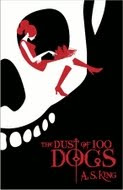 King, A.S. The Dust of 100 Dogs. Woodbury, Minn.: Flux-Llewellyn Publications, 2009. Print.[Book cover credit: librarything.com/work/6349011]
Awards:
King, A.S. The Dust of 100 Dogs. Woodbury, Minn.: Flux-Llewellyn Publications, 2009. Print.[Book cover credit: librarything.com/work/6349011]
Awards:
Spring 2009 Indie Next List pick for Teens
Booktalk:
Saffron is wise beyond her years, but not in the kooky
Dakota Fanning way that adults think when they say that. The ability to appear really serious, the ability to handle "mature situations," and the cunning to look young and sweet while you do it. Saffron has all that, but she also has memories dating back to the 1600s when she, then Emer, was a pirate captain whose trademark was popping out Spanish eyeballs. Back then she was cursed with the Dust of 100 Dogs to be reincarnated 101 times and to keep her memories from each life. The 1st 100 reincarnations she was a dog (as you may have guessed from the name of the curse/book). Now, in her 102 life, she can finally enjoy human existence again, if you can call living in Hollow Ford, PA in the swingin' 70s a "human existence." Finally escaped from life on 4 legs, Saffron (Emer) just needs to escape low income suburbia so she can reclaim what's hers. Buried treasure, of course. Somewhere in the Caribbean.
Review:
I didn't really know how to categorize this book until I read the author interview at the end with Leila of
bookshelves of doom. In the interview the author describes her book as magical realism, and that is so what this is! I had to reach back into my memories of my 9th grade World Literature class (Mr. Driscoll, you still rock and I promise to email you back real soon) to remember what magical realism really is. It is, from my memory and the author interview, when something a bit magic/supernatural/fantastical happens in the real world. It's not fantasy because there isn't a whole new world created and most of what happens could really happen. There are just a few magical moments in the midst of normalcy, like a
guy who grows angel wings or
candy that makes you a little sad.
Saffron's memory of her past lives is like that. She doesn't have any superpowers, she didn't even have any when she was a pirate captain. And no one eats people parts or turns into anything fancy under a full moon. To make up for this lack of the supernatural, we get little tidbits from Saffron's past lives as dogs. The whole book, which alternates between Emer's life from childhood to when she is cursed and Saffron's life in Hollow Ford and treasure hunting, is peppered with Dog Tips. These tips give little glimpses into the lives of dogs raised to be in dog fights, strays, the spoiled little dogs that get carried around in purses, and the times in history in which Saffron lived these lives.
The historical parts of this novel are well-researched, and it shows. Emer's life in Ireland is richly described and detailed, as is her life in the Caribbean. This book does not, however, read like historical fiction. It is not bogged down with description (not that historical fiction must be); little details are dropped into the narrative in a way that doesn't distract from the story, which remains high action no matter what time period it is portraying. The only time period that fell a little short for me was Saffron's current life. It felt a little too present day to be the 70s. The only way I could tell that Saffron wasn't in Hollow Ford yesterday is that no one had a cell phone, but when you're talking about really poor people who are robbed on a general basis by a tweaker family member, the lack of cell phones could still be current. This didn't detract from the story AT ALL for me. I simply forgot when Saffron was supposed to be.
The Dust of 100 Dogs was a really unique book and a really fun read. I think it will be a hit with the millions of readers of paranormal romance out there, even though it's not really a romance and it's not really paranormal, even though the main character has been reincarnated 101 times.I look forward to seeing what A.S. King will come up with for young adults in the future.
Book source: Philly Free Library







